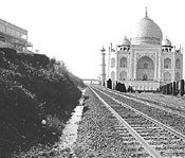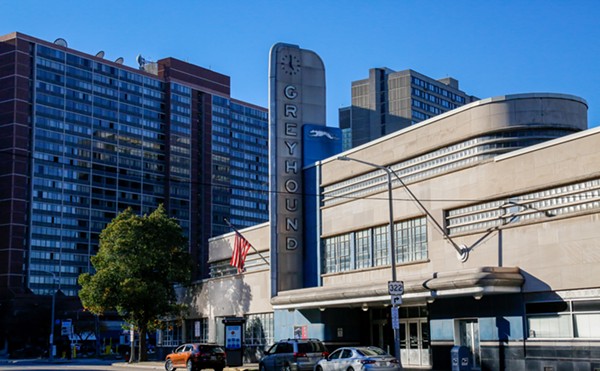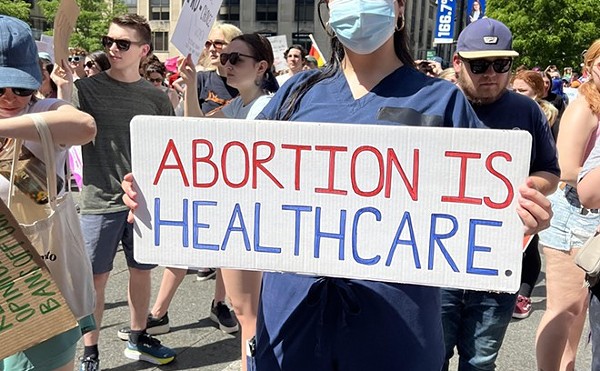Yet none of these stories addresses a most basic question: Will it work? And if you examine virtually any city in America, you'll find the answer is a resounding no.
Which means, of course, that we'll build it anyway.
So, to save you from reading any more convention center stories, Scene presents this handy Cliffs Notes version of how it will all go down. After all, other cities have been making this same mistake for 20 years now. If we can't learn from their failures, we can at least take solace in mocking our civic elite for yet another boondoggle.
Step 1: Business Leaders Clamor
Convention Center Crusades always begin with the vaunted Business Leaders. They unveil a simple proposition: We build a giant box downtown, and conventioneers from near and far descend upon Cleveland to have their wallets stripped by everyone from hoteliers to hookers. This sounds appealing, doesn't it?
But it's not so appealing that Business Leaders will put their money into it. No, the same people who believe government too inept to do much of anything have suddenly decided that, yes, government would be very good at the convention business. And it will cost taxpayers only $350-$600 million to get in on the score.
Okay, so Bert Wolstein has offered to build it himself, and Albert Ratner is offering up some land. But neither wants any part of the convention business. They're far more interested in something else: public loot. Wolstein wants a $19.5 million-a-year lease. Ratner wants to spur business at his nearby Tower City complex. Which leads us to . . .
Step 2: The All-Important Study
We, the general peasantry, tend not to trust executives bearing gifts. If the gifts were really good, they'd keep 'em for themselves. So say the laws of commerce.
Which means Business Leaders must commission the ever-important Independent Study, usually by a prominent accounting firm. You will note that these studies are always paid for by people seeking evidence that their plans are golden. You will also note that -- as we learned from the Enron scandal -- accountants and consultants will say damn near anything in the ecclesiastical pursuit of billable hours.
Hence, in city after city, they produce studies that might best be titled "Money Will Fall From The Sky: Christ Almighty, I Can't Believe You Haven't Jumped On This Yet!"
Just ask Heywood Sanders, a University of Texas-San Antonio professor and the big name in convention research. "I've looked at 50 of these things, and I have yet to find one that says 'Don't do it,' and I have yet to find one that isn't positive, and I have yet to find one that uses numbers of any significant reliability," he says.
Sanders tracks consultants' promises, then compares them to actual numbers once a center is built. According to his research, you can basically take all these glowing estimates and cut them by half -- then slice further based on a city's circumstances.
Witness Charlotte, whose new center generates only half the projected attendance and one-third the projected hotel stays. In fact, the new center hasn't even equaled the business of the old building. Which led the Charlotte Business Journal to ask, "We Built It, They Didn't Come, So Now What?" It's the same question being asked in St. Louis, Baltimore, Detroit, Minneapolis, (insert your favorite city here).
Cleveland, of course, is quite familiar with promises. The Rock Hall was supposed to attract one million visitors a year. It had just 575,000 in 2002. Gateway was supposed to generate 2,700 new jobs, but the guy with the jobs apparently got lost and delivered them to Mexico instead. Which brings us to . . .
Step 3: Provincial Pride
Okay, so you're not buying the whole study thing. Wise choice. But aren't we falling behind? Every city has a new convention center. Besides, Cleveland has so many unique and interesting things to offer!
Unfortunately, that's what everyone says. Omaha believes it's unique and interesting too, and has studies saying that people are simply dying to go there. (Sample question: Would you rather A) spend three days in Omaha or B) get repeatedly stabbed in the kidney?) It's now building a convention center, an arena, and a 450-room hotel. "Bookings are way below projections," says Sanders.
Here's the problem: Convention attendance peaked in 1989. It's been flat or declining since 1995. At the same time, convention space has doubled over the last 20 years, with 13 million more square feet set to go up in the next five.
Translation: It's a declining industry with a glut of competitors. Or, put another way: It's like Cleveland opening a Kmart on a block where five Kmarts are already hemorrhaging.
Vacation cities like Orlando, New Orleans, and Las Vegas lead the field for obvious reasons: cheap air travel, lots of inexpensive hotels, warm weather, theme parks, gambling, and general wholesome debauchery. By contrast, downtown Cleveland bars throw you out at 11:30 if the waitresses want to go home.
Even destination cities like New York, Chicago, and Washington, D.C., aren't meeting projections. And to stay alive, the rest are offering heavy inducements, such as free space, shuttle services, and receptions. They'll even pay for your keynote speaker.
Yes, this proposal will likely require you, the good people of Cleveland, to start funding self-help gurus with comb-overs.
Step 4: The Regional Powerhouse
"Are we going to compete with Las Vegas, New York City, Orlando?" asks county Commissioner Peter Lawson Jones. "No. But we can be the strongest competitor in the Midwest." He cites a 1997 study indicating conventioneers prefer Cleveland to Pittsburgh, Detroit, Columbus, and Cincinnati.
Sanders is familiar with the regional argument: "I hear from reporters all around the country every day saying the same thing."
Detroit presumably had a similar study. Its center opened in 1989. By 1997, after an investment of $200 million, its convention business was half of what it was in 1983, and its hotel business was less than 10 percent of consultants' forecasts. By Sanders's calculations, Detroit's public subsidy amounted to $155 per convention attendee, or about $520 per actual hotel room used.
Baltimore discovered the same thing. It spent $150 million on expansion in the early '90s. A few years later, its center was actually doing less business than before the expansion.
As Sanders notes, "You can't necessarily pick with whom you compete anymore." Everyone has facilities. Everyone has downtown amenities. And everyone is trumping one another in a rousing price war.
Besides, Cleveland has been through this before. Our convention center was rehabbed in the 1960s, and again under Mayor Voinovich. They didn't come.
Step 5: Build It Anyway
No one wants to talk about any of this. Not the media. Not the business guys. Not the politicians. Mayor Jane Campbell appears reticent, but everyone else speaks as though it's a done deal.
Soon, Business Leaders will release their All-Important Study. It will assure us through most impressive figures that, yes, people are just dying to ride Lolly the Trolley, freeze their asses off, and get kicked out of bars at 11:30. Cleveland will succeed where all others have failed.
Politicians will prepare for the November tax vote by tacking on pork-barrel funding for biotech, fuel cell, small business, and arts development. It will likely be the only government proposal in history where the pork has more merit than the central project. The final tab will near $1 billion.
Then, five years later, we will ask the same thing Charlotte asked: "We Built It, They Didn't Come, So Now What?" The response will be the same as it was in Minneapolis, Detroit, St. Louis, Baltimore, and all cities in between: Our convention center isn't big enough, Business Leaders will say. We're falling behind. We must build again.
Repeat steps 1-5.














